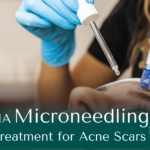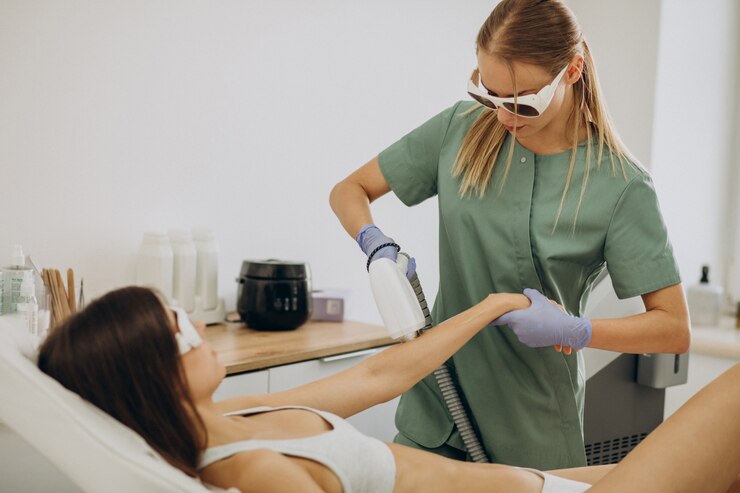When it comes to rejuvenating your skin and restoring its youthful glow, microdermabrasion and chemical peels are two popular options. Both treatments aim to exfoliate the skin, remove dead cells, and encourage the growth of fresh, healthy skin. However, they work differently and are suited to different skin types and concerns. In this article, we’ll …
When it comes to rejuvenating your skin and restoring its youthful glow, microdermabrasion and chemical peels are two popular options. Both treatments aim to exfoliate the skin, remove dead cells, and encourage the growth of fresh, healthy skin. However, they work differently and are suited to different skin types and concerns. In this article, we’ll explore the nuances of these treatments in following microdermabrasion vs chemical peels comparison to help you make an informed decision.
Caring for your skin requires choosing the right treatments that address your unique concerns without causing harm. Microdermabrasion and chemical peels are highly effective, but selecting between them depends on factors like your skin’s condition, desired outcomes, and tolerance for downtime. By understanding these treatments in depth, you can achieve radiant, healthy skin tailored to your needs. Let’s dive deeper into the differences b/w the two to know about the best Facial treatment in b/w them in following microdermabrasion vs chemical peels comparison to know about the best one as per needs.
What Is Microdermabrasion?
Microdermabrasion is a non-invasive skin resurfacing treatment that mechanically exfoliates the outermost layer of the skin. A handheld device is used to spray fine crystals or utilize a diamond-tipped wand to gently abrade the skin. At the same time, a vacuum mechanism removes exfoliated skin cells and debris.
This treatment is a popular choice among individuals looking for a painless, fast way to improve skin texture and shine. It’s soft enough for sensitive skin yet strong enough to make an important improvement. Microdermabrasion not only removes dead cells but also stimulates blood flow and collagen production, giving the skin a vibrant, youthful look.
Key Benefits of Microdermabrasion:
- Minimal Downtime: Often referred to as a “lunchtime treatment,” microdermabrasion requires little to no recovery time, allowing you to resume daily activities immediately.
- Gentle and Safe: This procedure is suitable for most skin types, including sensitive skin, as it doesn’t involve harsh chemicals.
- Improved Skin Texture: Microdermabrasion can effectively reduce the appearance of fine lines, minor scars, and superficial hyperpigmentation.
- Enhanced Product Absorption: By removing the outer layer of dead skin cells, it allows skincare products to penetrate more deeply and work more effectively.
Microdermabrasion Considerations:
- Microdermabrasion addresses superficial skin concerns and may not be effective for deeper wrinkles, scars, or significant hyperpigmentation.
- To attain the best effects, multiple treatments are usually required, spaced a few weeks apart.
- The treatment might not be suitable for individuals with active acne or certain skin conditions, such as rosacea.
What Are Chemical Peels?
Chemical peels include applying an acid-containing solution to the skin. These acids – commonly alpha hydroxy acids (AHAs), beta hydroxy acids (BHAs), or trichloroacetic acid (TCA) – exfoliate the skin by breaking down the bonds between dead skin cells, allowing them to shed more easily. Depending on the formulation and strength, chemical peels can be classified into three categories:
- Superficial Peels: Use mild acids like glycolic or lactic acid to gently exfoliate the outer layer of skin. These are ideal for addressing mild discoloration and rough texture.
- Medium Peels: Medium peels use stronger acids to penetrate the middle layers of skin, successfully addressing age spots, fine wrinkles, and moderate skin discolouration.
- Deep Peels: Employ potent acids to penetrate deeper skin layers, addressing severe wrinkles, scars, and precancerous growths.
Chemical peels are a versatile solution that can be customized to suit your specific skin goals. Whether you’re dealing with acne scars, uneven pigmentation, or fine lines, there’s likely a peel that matches your needs. These treatments not only improve the skin’s surface but also promote long-term health by encouraging cell turnover and collagen production.
Key Benefits of Chemical Peels:
- Customizable: Chemical peels can be tailored to address specific skin concerns, making them versatile and effective for a wide range of issues.
- Long-Lasting Results: Medium and deep peels often yield more significant and enduring results compared to superficial treatments.
- Stimulates Collagen Production: Encourages the growth of new, healthy skin cells, improving elasticity and firmness over time.
- Addresses Deeper Concerns: Perfect for treating more serious problems like acne scars, deep wrinkles, or considerable pigmentation.
Chemical Peels Considerations:
- Medium and deep peels may require significant downtime, with peeling, redness, and sensitivity lasting for several days to weeks.
- These treatments carry a higher risk of side effects, including scarring, infection, and changes in skin color, especially for deeper peels.
- Not all chemical peels are suitable for darker skin tones or sensitive skin types due to the potential for post-inflammatory hyperpigmentation.
Key Differences Between microdermabrasion vs chemical peels
| Microdermabrasion | Chemical Peels | |
| Method | Mechanical exfoliation with crystals or wands | Chemical exfoliation with acid-based solutions |
| Depth of Action | Surface level | Can range from superficial to deep |
| Downtime | Minimal to none | Varies; can range from none to several weeks |
| Targeted Concerns | Minor texture issues, fine lines, dullness | Wrinkles, pigmentation, scars, acne |
| Suitability | Safe for most skin types | Requires professional assessment for suitability |
Who Should Choose Microdermabrasion?
Microdermabrasion is an excellent choice if you’re looking for a quick, non-invasive treatment with minimal downtime. It’s ideal for:
- Individuals with minor skin concerns, such as dullness, fine lines, or slight unevenness in texture.
- Those who prefer a gentle treatment and want to avoid harsh chemicals.
- People with sensitive skin who might not tolerate stronger treatments.
- Individuals seeking to enhance the effectiveness of their skincare products.
When to Avoid Microdermabrasion:
- If you have active acne, as the procedure may irritate the skin and spread bacteria.
- If you have rosacea or broken capillaries, as the mechanical action can exacerbate redness.
Pro Tip: For best results, incorporate a gentle skincare routine post-treatment to maintain your skin’s health and radiance. Hydration and sun protection are key to prolonging the effects of microdermabrasion.
Who Should Choose Chemical Peels?
Chemical peels are more suited for individuals with specific or more severe skin concerns. They are ideal for:
- Treating moderate to severe pigmentation, acne scars, or wrinkles.
- Those seeking long-lasting results with fewer sessions.
- Individuals comfortable with potential downtime and post-treatment care.
When to Avoid Chemical Peels:
- If you have very sensitive skin or certain medical conditions that make your skin prone to irritation.
- If you’re pregnant or breastfeeding, as some chemical peel ingredients may not be safe during this time.
- If you’ve recently had other skin treatments like laser therapy, which may increase sensitivity.
Pro Tip: Always follow post-peel care instructions carefully. This includes avoiding sun exposure, using a gentle cleanser, and applying a broad-spectrum sunscreen to protect your skin as it heals and regenerates.
Combining Treatments for Enhanced Results
For individuals seeking comprehensive skin rejuvenation, combining microdermabrasion and chemical peels can be an effective strategy. Microdermabrasion can be performed first to remove the outer layer of dead skin, allowing the chemical peel to penetrate more deeply and work more effectively.
Benefits of Combining Treatments:
- Enhanced Exfoliation: Double-layer exfoliation for more dramatic results.
- Maximized Product Penetration: Improved absorption of chemical peel ingredients.
- Customizable Solutions: Treatments can be tailored to address multiple skin concerns simultaneously.
It’s crucial to consult a licensed dermatologist or skincare professional to determine the safest and most effective combination for your skin type and concerns.
Conclusion
Both microdermabrasion and chemical peels offer significant benefits for skin rejuvenation. Choosing the right treatment depends on your individual skin type, concerns, and goals. Microdermabrasion is a gentle, non-invasive option for those seeking to address minor issues with minimal downtime, while chemical peels provide more intensive results for deeper skin concerns. Beside this Facial treatments, there are several other facial treatments which provides benefits to overall beauty like Hydrafacial MD and many others.
Consult with a skincare professional to assess your needs as per the insights given above comparing microdermabrasion vs chemical peels and craft a treatment plan tailored to your unique skin. Whether you choose microdermabrasion, chemical peels, or a combination of both, the key to achieving glowing, healthy skin lies in consistent care and professional guidance. Achieving a beautiful complexion is just one aspect of a holistic approach to wellness. While microdermabrasion helps you address your skin concerns, there are also treatments like PRP for physical well-being. Discover how PRP therapy for shoulder pain can be a natural solution to help you regain your active lifestyle.







